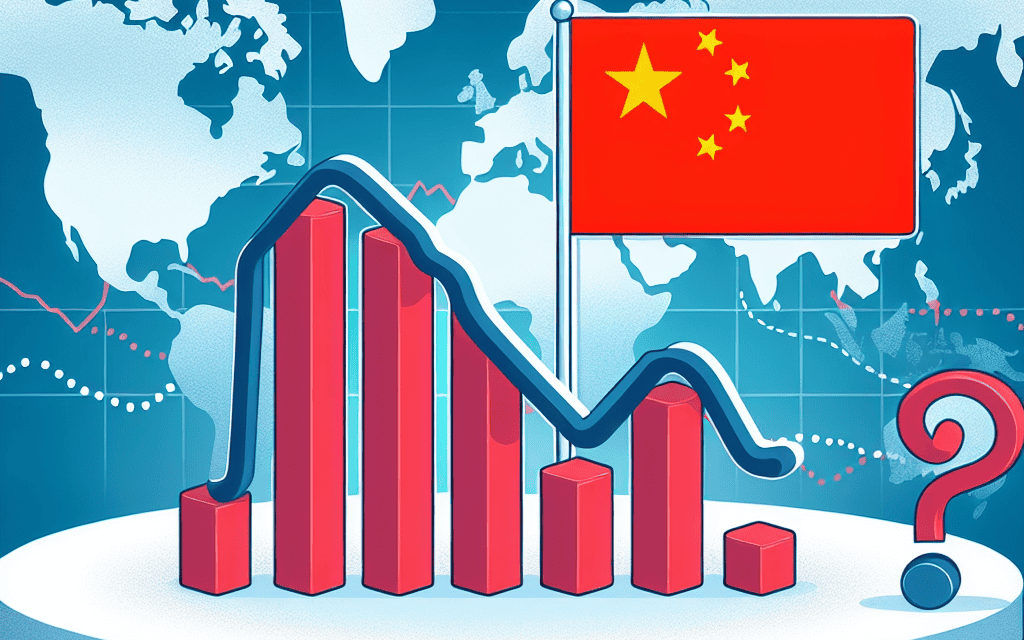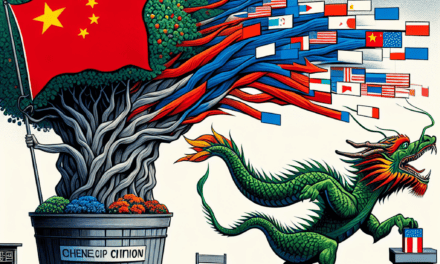“Oil Prices Dip: Stability and Demand Concerns Shape the Global Market”
Introduction
Oil prices have recently experienced a decline, influenced by a combination of stabilized geopolitical risks and concerns over China’s demand. The easing of tensions in key oil-producing regions has contributed to a more stable supply outlook, alleviating fears of potential disruptions. Meanwhile, China’s economic trajectory, a significant driver of global oil demand, has raised concerns among market participants. Slower-than-expected growth and shifts in energy consumption patterns within China have added downward pressure on oil prices. This confluence of factors underscores the complex interplay between geopolitical stability and economic dynamics in shaping the global oil market landscape.
Impact Of Stabilized Geopolitical Risks On Global Oil Prices
The recent decline in oil prices can be attributed to a confluence of factors, primarily the stabilization of geopolitical risks and concerns over China’s demand. As geopolitical tensions ease, the global oil market has experienced a period of relative calm, which has contributed to the downward pressure on prices. This stabilization is particularly significant given the volatility that has characterized the oil market in recent years, often driven by conflicts in key oil-producing regions. The easing of these tensions has provided a sense of predictability, allowing market participants to adjust their expectations and strategies accordingly.
In addition to the geopolitical landscape, China’s economic outlook plays a crucial role in shaping global oil prices. As the world’s largest importer of crude oil, China’s demand significantly influences market dynamics. Recent indicators suggest a slowdown in China’s economic growth, raising concerns about its future oil consumption. This has led to a reassessment of demand forecasts, further contributing to the decline in oil prices. The interplay between geopolitical stability and China’s demand concerns underscores the complexity of the global oil market, where multiple factors simultaneously impact pricing.
Moreover, the stabilization of geopolitical risks has had a ripple effect on other aspects of the oil market. For instance, with reduced tensions, there is less likelihood of supply disruptions from major oil-producing regions. This has alleviated fears of sudden shortages, which often lead to price spikes. Consequently, the market has seen a more balanced supply-demand equation, fostering a more stable pricing environment. This newfound stability is a welcome change for both producers and consumers, who have had to navigate a highly unpredictable market landscape in recent years.
Furthermore, the decline in oil prices has broader economic implications. For oil-importing countries, lower prices translate into reduced energy costs, which can stimulate economic growth by increasing disposable income and reducing inflationary pressures. On the other hand, oil-exporting nations may face budgetary challenges as their revenues decrease. This dual impact highlights the interconnectedness of global economies and the pivotal role that oil prices play in shaping economic trajectories.
In light of these developments, market analysts are closely monitoring the situation to gauge future trends. While the current stabilization of geopolitical risks and concerns over China’s demand have led to a decline in oil prices, the market remains susceptible to sudden changes. Factors such as unexpected geopolitical events, shifts in production levels by major oil producers, or changes in global economic conditions could quickly alter the current trajectory. Therefore, stakeholders in the oil market must remain vigilant and adaptable to navigate the ever-evolving landscape.
In conclusion, the decline in oil prices amid stabilized geopolitical risks and concerns over China’s demand reflects the intricate dynamics of the global oil market. The easing of geopolitical tensions has provided a degree of stability, while China’s economic outlook continues to be a critical factor influencing demand forecasts. As the market adjusts to these developments, the broader economic implications underscore the importance of understanding the multifaceted nature of oil pricing. Moving forward, the ability to anticipate and respond to changes in these key areas will be essential for market participants seeking to thrive in this complex environment.
China’s Economic Slowdown: A Key Factor In Oil Price Decline
In recent months, the global oil market has witnessed a notable decline in prices, a trend largely attributed to a combination of stabilized geopolitical risks and concerns over China’s economic slowdown. As the world’s second-largest economy, China’s demand for oil plays a pivotal role in shaping global energy markets. Consequently, any fluctuations in its economic performance can have far-reaching implications for oil prices worldwide. The current decline in oil prices can be traced back to a confluence of factors, with China’s economic slowdown emerging as a key driver.
To begin with, China’s economic growth has been decelerating, a development that has raised alarms among global investors and policymakers. The country’s transition from an investment-driven growth model to one that emphasizes consumption and services has been fraught with challenges. This shift has led to a reduction in industrial activity, which in turn has dampened the demand for oil. As factories produce less and construction projects slow down, the need for energy resources diminishes, exerting downward pressure on oil prices.
Moreover, the Chinese government’s efforts to manage its debt levels and implement structural reforms have further contributed to the economic slowdown. These measures, while necessary for long-term stability, have resulted in short-term economic pain. The tightening of credit conditions and the crackdown on shadow banking have constrained liquidity, affecting businesses’ ability to invest and expand. This has led to a decrease in industrial output and, consequently, a reduced appetite for oil imports.
In addition to domestic factors, external challenges have also played a role in China’s economic slowdown. The ongoing trade tensions with the United States have created an atmosphere of uncertainty, affecting business confidence and investment decisions. Although there have been intermittent signs of progress in trade negotiations, the lack of a comprehensive resolution has continued to weigh on China’s economic prospects. This uncertainty has further dampened demand for oil, as businesses remain cautious about future growth.
While China’s economic slowdown is a significant factor in the decline of oil prices, it is important to consider the broader context of stabilized geopolitical risks. In recent years, geopolitical tensions in key oil-producing regions have often led to supply disruptions and price volatility. However, recent developments have contributed to a more stable geopolitical landscape. For instance, diplomatic efforts in the Middle East have reduced the likelihood of major conflicts that could disrupt oil supplies. Additionally, the easing of sanctions on certain oil-producing countries has allowed for increased production, contributing to a more balanced supply-demand dynamic.
As a result of these factors, the global oil market has experienced a period of relative stability, with prices reflecting the interplay between supply and demand dynamics. While the decline in oil prices may pose challenges for oil-exporting countries, it also presents opportunities for oil-importing nations to benefit from lower energy costs. This, in turn, can stimulate economic growth and provide a buffer against inflationary pressures.
In conclusion, the decline in oil prices can be attributed to a combination of stabilized geopolitical risks and concerns over China’s economic slowdown. As China continues to navigate its economic transition, the global oil market will remain sensitive to developments in the country’s economic performance. While the current decline in oil prices presents challenges and opportunities, it underscores the interconnectedness of global economies and the importance of monitoring key economic indicators. As such, stakeholders in the energy sector must remain vigilant and adaptable to navigate the evolving landscape of the global oil market.
How Geopolitical Stability Is Influencing Oil Market Trends
In recent months, the global oil market has experienced a notable decline in prices, a trend largely attributed to the stabilization of geopolitical risks and concerns over China’s demand. This development marks a significant shift from the volatility that has characterized the oil market in recent years, driven by a confluence of factors that have collectively contributed to a more stable geopolitical landscape. As tensions in key oil-producing regions have eased, market participants have responded with increased confidence, leading to a recalibration of oil prices.
One of the primary factors contributing to this stabilization is the de-escalation of conflicts in the Middle East, a region historically known for its geopolitical volatility. Diplomatic efforts have borne fruit, resulting in improved relations between major players such as Saudi Arabia and Iran. This thawing of hostilities has reduced the risk of supply disruptions, which in turn has alleviated upward pressure on oil prices. Furthermore, the ongoing negotiations and tentative agreements in other conflict-prone areas have fostered a sense of optimism among investors, who are now less inclined to factor in geopolitical risk premiums when assessing oil prices.
In addition to the Middle East, the resolution of certain trade disputes has also played a crucial role in stabilizing the geopolitical environment. The easing of tensions between the United States and China, for instance, has had a ripple effect on global markets, including the oil sector. As the world’s largest importer of oil, China’s demand significantly influences global oil prices. However, recent concerns over China’s economic slowdown have tempered expectations of robust demand growth. The Chinese government’s efforts to stimulate the economy have yet to yield the desired results, leading to apprehensions about the country’s future oil consumption. Consequently, these demand concerns have exerted downward pressure on oil prices, further contributing to their decline.
Moreover, the stabilization of geopolitical risks has coincided with a period of increased oil production from non-OPEC countries, particularly the United States. The shale revolution has enabled the U.S. to become a major player in the global oil market, with production levels reaching record highs. This surge in supply has provided a buffer against potential disruptions, thereby enhancing market stability. As a result, the balance between supply and demand has shifted, with ample supply mitigating the impact of any sudden changes in demand dynamics.
While the current geopolitical stability has been a boon for the oil market, it is important to recognize that this equilibrium remains fragile. Geopolitical tensions can resurface unexpectedly, and any escalation could quickly reverse the current trend of declining oil prices. Additionally, the global economic landscape is subject to various uncertainties, including inflationary pressures and monetary policy shifts, which could influence oil demand and, consequently, prices.
In conclusion, the recent decline in oil prices can be attributed to a combination of stabilized geopolitical risks and concerns over China’s demand. The easing of tensions in key regions, coupled with increased oil production from non-OPEC countries, has contributed to a more balanced market. However, the inherent volatility of geopolitical dynamics and economic uncertainties necessitates vigilance among market participants. As the global landscape continues to evolve, the interplay between geopolitical stability and oil market trends will remain a critical area of focus for industry stakeholders and policymakers alike.
The Role Of China’s Demand In Shaping Global Oil Prices

The global oil market is a complex and dynamic system influenced by a myriad of factors, with China’s demand playing a pivotal role in shaping oil prices. As the world’s largest importer of crude oil, China’s economic activities and energy consumption patterns significantly impact global oil markets. Recently, oil prices have experienced a decline, attributed to stabilized geopolitical risks and concerns over China’s demand. Understanding the interplay between these elements is crucial for comprehending the current trends in oil prices.
China’s rapid industrialization and urbanization over the past few decades have led to a substantial increase in its energy needs, making it a key player in the global oil market. The country’s demand for oil is driven by its manufacturing sector, transportation needs, and overall economic growth. Consequently, any fluctuations in China’s economic performance or energy policies can have far-reaching effects on global oil prices. In recent months, concerns have emerged regarding China’s economic slowdown, which has raised questions about its future oil demand. These concerns are primarily rooted in the country’s ongoing structural reforms, aimed at transitioning from an investment-driven economy to one focused on consumption and services. As a result, there is uncertainty about the pace of China’s economic growth and its subsequent impact on oil consumption.
Moreover, the Chinese government’s efforts to diversify its energy sources and reduce reliance on fossil fuels have further contributed to the uncertainty surrounding its oil demand. Initiatives to promote renewable energy, increase energy efficiency, and reduce carbon emissions are part of China’s broader strategy to address environmental challenges and achieve sustainable development. While these measures are commendable, they also introduce an element of unpredictability in the global oil market, as they may lead to a gradual decline in China’s oil imports over time.
In addition to China’s demand concerns, the stabilization of geopolitical risks has also played a role in the recent decline in oil prices. Historically, geopolitical tensions in key oil-producing regions have led to supply disruptions and price volatility. However, recent developments, such as diplomatic efforts to resolve conflicts and increased production from major oil producers, have contributed to a more stable geopolitical environment. This stability has alleviated some of the supply-side pressures on the oil market, allowing prices to adjust downward.
The interplay between China’s demand concerns and stabilized geopolitical risks highlights the interconnectedness of global oil markets. While China’s economic trajectory and energy policies remain critical factors, the broader geopolitical landscape also plays a significant role in shaping oil prices. As such, market participants must closely monitor developments in both areas to make informed decisions.
In conclusion, the recent decline in oil prices can be attributed to a combination of stabilized geopolitical risks and concerns over China’s demand. As the global oil market continues to evolve, understanding the role of China’s demand and its interaction with other factors is essential for anticipating future price trends. While uncertainties remain, particularly regarding China’s economic outlook and energy transition, the current environment presents an opportunity for market participants to reassess their strategies and adapt to the changing dynamics of the global oil market.
Analyzing The Correlation Between Geopolitical Risks And Oil Prices
The intricate relationship between geopolitical risks and oil prices has long been a subject of analysis for economists and policymakers alike. Recent developments have seen a decline in oil prices, attributed to a stabilization of geopolitical risks and concerns over China’s demand. Understanding this correlation requires a nuanced examination of the factors at play.
Historically, geopolitical tensions have been a significant driver of oil price volatility. Conflicts in oil-rich regions, such as the Middle East, often lead to fears of supply disruptions, prompting price spikes. However, the current landscape presents a different narrative. Recent diplomatic efforts and peace negotiations in previously volatile regions have contributed to a more stable geopolitical environment. This stabilization has alleviated fears of immediate supply disruptions, thereby exerting downward pressure on oil prices.
Simultaneously, the global oil market is closely monitoring China’s economic trajectory. As the world’s largest importer of crude oil, China’s demand significantly influences global oil prices. Recent economic indicators suggest a slowdown in China’s growth, raising concerns about its future oil consumption. Factors such as a sluggish real estate market, regulatory crackdowns on key industries, and ongoing trade tensions have contributed to this economic deceleration. Consequently, the anticipated reduction in China’s oil demand has further contributed to the decline in oil prices.
Moreover, the interplay between geopolitical risks and China’s demand concerns is not isolated. The global oil market operates within a complex web of interdependencies. For instance, the stabilization of geopolitical risks has encouraged increased oil production from major producers, such as the United States and OPEC members. This increase in supply, coupled with the potential decrease in demand from China, has created a supply-demand imbalance, further driving down prices.
In addition to these factors, technological advancements and shifts in energy policies are reshaping the oil market landscape. The global push towards renewable energy sources and the adoption of electric vehicles are gradually reducing the world’s reliance on fossil fuels. This transition, while still in its nascent stages, is beginning to influence long-term oil price projections. As countries commit to reducing carbon emissions and investing in sustainable energy, the traditional dynamics of oil supply and demand are being redefined.
Furthermore, the role of financial markets cannot be overlooked in this analysis. Speculative trading and investor sentiment play a crucial role in oil price fluctuations. The current sentiment, influenced by stabilized geopolitical risks and concerns over China’s demand, has led to bearish market behavior. Investors, anticipating a prolonged period of lower demand and stable supply, are adjusting their positions accordingly, contributing to the downward trend in oil prices.
In conclusion, the decline in oil prices amid stabilized geopolitical risks and China’s demand concerns underscores the multifaceted nature of the global oil market. While geopolitical stability has alleviated fears of supply disruptions, concerns over China’s economic slowdown have raised questions about future demand. These factors, combined with technological advancements and evolving energy policies, are reshaping the traditional dynamics of the oil market. As the world continues to navigate these complexities, understanding the correlation between geopolitical risks and oil prices remains crucial for stakeholders seeking to make informed decisions in an ever-evolving landscape.
Future Outlook: Oil Prices Amid Evolving Geopolitical And Economic Factors
The recent decline in oil prices can be attributed to a confluence of stabilized geopolitical risks and concerns over China’s demand, which have collectively influenced the global energy market. As we look to the future, understanding the interplay of these factors is crucial for anticipating potential shifts in oil prices. Geopolitical tensions, particularly in key oil-producing regions, have historically been a significant driver of oil price volatility. However, recent developments suggest a stabilization of these risks, contributing to the current downward trend in prices. For instance, diplomatic efforts in the Middle East have led to a reduction in hostilities, thereby ensuring a more consistent supply of oil from this critical region. Additionally, the easing of sanctions on certain countries has allowed for increased production and exportation, further stabilizing the global oil supply.
Simultaneously, China’s economic trajectory plays a pivotal role in shaping global oil demand. As the world’s largest importer of crude oil, China’s economic health directly impacts global oil markets. Recent data indicating a slowdown in China’s economic growth has raised concerns about its future oil consumption. Factors such as a sluggish real estate market, regulatory crackdowns on key industries, and ongoing challenges related to the COVID-19 pandemic have contributed to a more cautious outlook on China’s demand for oil. Consequently, these concerns have exerted downward pressure on oil prices, as market participants adjust their expectations for future demand.
Moreover, the global transition towards renewable energy sources and increased energy efficiency continues to influence the long-term outlook for oil prices. As countries strive to meet their climate commitments, investments in alternative energy technologies are accelerating. This shift is gradually reducing the world’s reliance on fossil fuels, thereby impacting the demand dynamics for oil. While this transition is expected to unfold over several decades, its implications are already being felt in the market, as investors and policymakers alike reassess the future role of oil in the global energy mix.
In addition to these factors, the role of major oil-producing nations and organizations, such as OPEC and its allies, remains a critical element in determining oil prices. These entities have historically wielded significant influence over production levels, thereby affecting global supply and prices. Recent decisions by OPEC+ to adjust production quotas in response to market conditions highlight their ongoing impact on the oil market. As these organizations continue to navigate the complexities of balancing supply and demand, their actions will undoubtedly shape the future trajectory of oil prices.
Looking ahead, the interplay of geopolitical stability, economic developments in China, the global energy transition, and the strategic decisions of oil-producing nations will collectively determine the future outlook for oil prices. While current trends suggest a period of relative stability, the inherent volatility of the oil market necessitates a cautious approach. Market participants must remain vigilant, continuously monitoring these evolving factors to make informed decisions. As the world grapples with the dual challenges of ensuring energy security and addressing climate change, the future of oil prices will be shaped by a complex web of geopolitical and economic considerations. Understanding these dynamics will be essential for navigating the uncertainties of the global energy landscape in the years to come.
Strategies For Oil Producers In A Market With Declining Prices And Demand Concerns
In the ever-fluctuating world of oil markets, producers are constantly navigating a landscape shaped by geopolitical tensions, economic shifts, and demand fluctuations. Recently, oil prices have experienced a decline, primarily due to stabilized geopolitical risks and concerns over China’s demand. This scenario presents a unique set of challenges and opportunities for oil producers, who must strategically adapt to maintain profitability and market relevance.
To begin with, understanding the underlying factors contributing to the current market conditions is crucial. The stabilization of geopolitical risks, particularly in key oil-producing regions, has alleviated some of the supply-side pressures that previously drove prices upward. Additionally, China’s economic slowdown has raised concerns about reduced demand from one of the world’s largest oil consumers. These elements combined have led to a softening of oil prices, prompting producers to reassess their strategies.
In response to declining prices, oil producers can consider several strategic approaches. One effective strategy is cost optimization. By focusing on reducing operational costs, producers can maintain profitability even when prices are low. This can be achieved through technological advancements, such as automation and digitalization, which enhance efficiency and reduce waste. Moreover, renegotiating contracts with suppliers and service providers can also lead to cost savings, allowing producers to better weather the storm of fluctuating prices.
Another strategy involves diversifying product offerings. By expanding into alternative energy sources or investing in downstream operations, such as refining and petrochemicals, producers can create additional revenue streams. This diversification not only mitigates the risks associated with reliance on crude oil sales but also positions companies to capitalize on the growing demand for cleaner energy solutions. As the global energy landscape continues to evolve, having a diversified portfolio can provide a competitive edge.
Furthermore, strategic partnerships and collaborations can play a pivotal role in navigating a market characterized by declining prices and demand concerns. By forming alliances with other industry players, producers can share resources, knowledge, and technology, leading to cost reductions and enhanced innovation. Joint ventures in exploration and production can also spread financial risk, making it easier to undertake large-scale projects that might be unfeasible for a single entity.
In addition to these strategies, maintaining a keen focus on market intelligence is essential. By closely monitoring market trends, geopolitical developments, and economic indicators, producers can make informed decisions and swiftly adapt to changing conditions. This proactive approach enables companies to anticipate shifts in demand and supply dynamics, allowing them to adjust production levels and pricing strategies accordingly.
Lastly, engaging with policymakers and stakeholders is crucial for oil producers operating in a complex regulatory environment. By actively participating in discussions on energy policy and sustainability, producers can help shape regulations that support industry growth while addressing environmental concerns. This engagement not only fosters a positive public image but also ensures that producers are well-positioned to comply with evolving regulations.
In conclusion, while declining oil prices and demand concerns present significant challenges, they also offer opportunities for oil producers to innovate and adapt. By focusing on cost optimization, diversification, strategic partnerships, market intelligence, and regulatory engagement, producers can navigate this complex landscape and emerge stronger. As the global energy market continues to evolve, those who embrace change and adopt forward-thinking strategies will be best positioned to thrive in the face of uncertainty.
Q&A
1. **What are the main reasons for the recent decline in oil prices?**
– The decline in oil prices is primarily due to stabilized geopolitical risks and concerns over China’s demand.
2. **How have geopolitical risks stabilized?**
– Geopolitical risks have stabilized due to easing tensions in key oil-producing regions and successful diplomatic efforts that have reduced the likelihood of supply disruptions.
3. **Why is China’s demand a concern for oil prices?**
– China’s demand is a concern because it is one of the largest consumers of oil. Economic slowdowns or policy changes in China can significantly impact global oil demand and prices.
4. **What impact does a decline in oil prices have on global markets?**
– A decline in oil prices can lead to lower energy costs, affecting inflation rates, consumer spending, and the profitability of oil-producing companies, which in turn influences global stock markets and economies.
5. **How do oil-producing countries respond to declining oil prices?**
– Oil-producing countries may respond by adjusting production levels, engaging in diplomatic negotiations to stabilize prices, or implementing economic measures to mitigate the impact on their economies.
6. **What role do OPEC and non-OPEC countries play in oil price stabilization?**
– OPEC and non-OPEC countries often collaborate to manage oil production levels, aiming to balance supply and demand to stabilize prices.
7. **What are the potential long-term effects of sustained low oil prices?**
– Sustained low oil prices can lead to reduced investment in oil exploration and production, financial strain on oil-dependent economies, and shifts towards alternative energy sources.
Conclusion
The recent decline in oil prices can be attributed to a combination of stabilized geopolitical risks and concerns over China’s demand. As geopolitical tensions ease, the risk premium that often inflates oil prices has diminished, leading to a more stable market environment. Concurrently, China’s economic outlook has raised concerns about its energy consumption, as indicators suggest a potential slowdown in demand from one of the world’s largest oil consumers. This dual impact of reduced geopolitical tensions and uncertain demand from China has contributed to the downward pressure on oil prices, reflecting a market adjusting to these evolving global dynamics.





